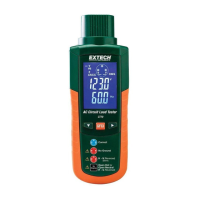Test 5: Impedance (Z) Measurements
The impedance measurement capability of the CT70 is used to check Hot and Neutral impedance
when voltage drop measurements are too high (greater than 5%). To determine where the problem
is, measure the impedances and analyze the data as follows:
• If one impedance measurement is exceedingly higher than the other then the problem is
with the conductor that shows the higher impedance.
• If both impedances are high the problem could be an undersized conductor, a faulty load, or
poor connections.
Ground impedance should be less than 1 Ω, preferably in the 0.25 Ω region to ensure that the
ground conductor can safely return current when necessary.
Surge suppressors require good grounding to adequately protect against transient voltages.
Note: A small amount of current is applied to the ground conductor during impedance measurements
and can trip a GFCI circuit.
High Impedance Troubleshooting Suggestions
Problems Likely Causes Probable Solutions
High hot and/or neutral impedance
(Limit: 0.048Ω / ft of 14 AWG wire)
Excessive loading Redistribute loads
High hot and/or neutral impedance
(Limit: 0.03 Ω / ft of 12 AWG wire)
Undersized wiring
Check code and rewire if
necessary
High hot and/or neutral impedance
(Limit: 0.01
Ω / ft of 10 AWG wire)
High resistance connection in
the circuit or at the panel
Locate bad connection and rewire
or replace
High Ground impedance (Limit: 1Ω for
personal protection)
Undersized wiring
Check code and rewire if
necessary
High Ground impedance (Limit: 0.25Ω
for equipment protection
High resistance connection in
the circuit or at the panel
Locate bad connection and rewire
or replace

